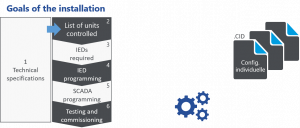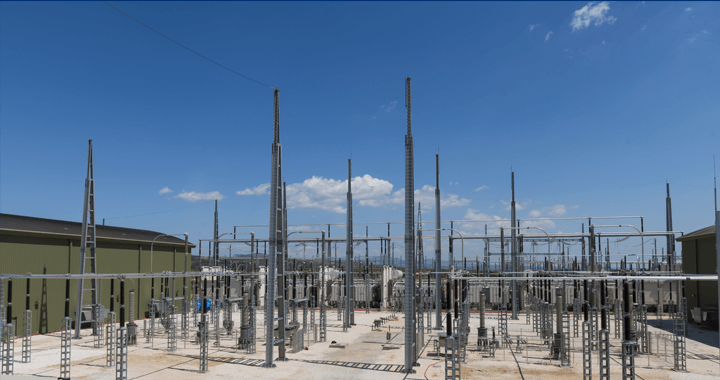Independent of major equipment vendors and developed specifically for the needs of electricity grid management, the international standard IEC 61850 sets out specifications for the entire value chain: from instrumentation and control (I&C) of automation systems to energy SCADA applications.
This technology includes the challenges of time stamped data management plus distributed networked services and protocols. It also offers powerful IT engineering mechanisms focused on safety rules and operational specifications (e.g. description of an object oriented substation and equipment configured with logical nodes, ethernet communication bus and associated substation configuration language with message specification, GOOSE messaging, etc.).
As an independent SCADA specialist working for decades in the energy and nuclear sectors, Codra has made a strategic choice of natively integrating the IEC standard 61850 into its software platform. This connection with SCADA applications is designed to strengthen energy management capabilities (EMS), and gives you versatility when operating “high voltage” electrical installations (on-call service, technical management and access control).
New technology to support the growth of smart grids
Little known 5 years ago, IEC 61850 is now increasingly used in Europe as a digital I&C system for electrical power installations. The emergence of renewable energies (wind, photovoltaic and energy storage systems) and their inherently intermittent nature, coupled with the challenges of electric mobility and energy efficiency, is accelerating deployment of the Smart Grid principle. Smart electricity grids are therefore becoming essential, and hence so is IEC 61850.
This standard is the direct result of the experience accumulated by companies operating in the electricity industry. It comprises of a regulatory framework that can be used to:
- Guarantee standard operation of equipment without having to rely on a given brand;
- Streamline design, implementation and maintenance in accordance with a defined and described procedure;
- Standardize interfaces and communications, and facilitate interoperability, substation configuration and in-service support;
- Reduce maintenance costs and improve profitability to increase the lifetime of installations.
This is not only applicable to operators of electrical substation I&C systems, but also to so-called ‘electro-intensive’ companies working in industrial manufacturing (e.g.: hydrogen production, metallurgy, rail networks, etc.), transport and power distribution companies, while also covering the energy consumption of buildings and infrastructure (e.g. stadiums and high-rise buildings).
But what is IEC 61850?
The IEC (International Electrotechnical Commission), an organization with more than 60 active member countries (and 90 other affiliates), is a world leader in electricity regulation, I&C standards, and associated communication standards and communication network system standards. Established in the 2000s, standard 61850 is not limited solely to its protocols (GOOSE, MMS, SMV), but more broadly incorporates an installation specification process designed to ensure operational safety. When implementing IEC 61850, all components of the project are listed, starting with electrical devices (relays, circuit breakers, transformers, etc.), then the various protection devices, followed by the programming of automatic control systems and RTUs. The whole process is broken down into 6 steps:

*IED : Intelligent electronic device
All of these organizational elements have matching technical and digital components. This includes integration of functions whose implementation covers the phases from design of the system to its real-time control.
What’s the best SCADA software for implementing IEC standard 61850?
An independent and future-proof solutionsolution indépendante et pérenne
Choosing IEC 61850 means choosing interoperability, openness, safety / security and a multi-brand approach. More broadly speaking, a software solution based on these values must also be independent from manufacturers, widely proven and easily extendable (Hypervision) to allow the connection of future electrical installations. It must also include an active cybersecurity component. On this last point, operators of power distribution networks that are listed as French operators of vital importance (OIVs), must be able to use hardware and software certified and recognized by ANSSI*.
Native implementation of the standard
This standard is more than just a simple exchange of data as in the case of Modbus or DNP 3. It is infinitely richer and also includes a services component (select before operate, etc.). It also offers technical elements that do not exist in other protocols, such as a 100 nanosecond (0.000 000 001 second) time stamp. If passing through a gateway, , to name one example, can no longer be extended up to supervisor level.
The Codra teams have chosen to implement the logic used in 61850 (MMS protocol) directly in the Panorama SCADA platform. The entire operational chain is therefore covered: from the design phase, with tools that can be used to import the specifications of electronic devices (IED data models and contextualization), and even the possibility of creating an IEC library to facilitate application implementation and maintenance.
This convergence allows you to:
- Facilitate construction of a power SCADA application and its commissioning (creation, test procedures)
- Quickly carry out maintenance operations (modifications, upgrades)
- Improve hardware obsolescence management (interoperability)
- Base the life cycle of the installation on a proven and future-proof solution (durability and robustness).
IEC 61850 and Panorama Suite, the linchpin of Industry 4.0 and the Smart City
Designed to facilitate high-performance energy SCADA applications for industrial manufacturers, power utilities and all “electro-intensive” businesses, IEC 61850 has established itself as the primary support for controlling their equipment. It offers both technical and functional benefits and can be used to provide concrete responses across the entire value chain: from IEDs to SCADA applications.
But to take full advantage of what it offers in terms of design, operation and maintenance, each element in the chain must support the basic principles of the standard. This will therefore affect both hardware and software components, and is why Codra has chosen to natively implement IEC 61850 in the Panorama environment. This will allow its clients and users to harness all the power of the standard while supporting them through technology changes, so that they are free to focus on tackling the energy performance challenges of Industry 4.0 and the Smart City.






